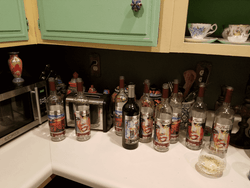If wine is made from grapes, then where exactly, do all of the complex fruit flavors come from? It’s a fair question and a pretty good one at that. This is especially true, if you’re considering delving into the exclusive world of wine enthusiasts. The flavor profile of a wine is made up of something called stereoisomers, or aroma compounds. These compounds are released during, and in harmony with, the fermentation method. Winemaking is an intricate process, some may say (including me) it is an art. The wide variety of these aromas are what make wine tasting such a popular pastime.
Today I break down the most common fruit flavors found in popular wine types. Let’s also take a look at the minor tweaks that can completely transform the taste!
Red VS Dark VS Citrus Fruit Flavors:
While the foundation of the vast majority of all wine is made from grapes, the actual winemaking process itself is where all of the beautiful flavors are drawn out and intricately intertwined. Most, but not all, wine flavor profiles fall into three main categories, red fruit, dark fruit, and citrus. Red fruit is going to include popular fruits found in wine such as cherry and strawberry. Dark fruit would be referring to such flavors as blueberry and black currant. Lastly, the citrus category would have your lemon, lime, and other citrus fruits covered. Now, admittedly, this is being more than a little simplistic as the flavors in wine are especially complex, which is what makes this sophisticated pastime so enjoyable.
Some of the Commonly Found Fruit Flavors in Your Favorite Wine:
While keeping in mind that the flavors found in wine are incredibly intricate (isn’t that why we appreciate it so much?), each of your favorite types tends to have their very own well-known characteristics.
Popular Dark Fruit Wines:
- Pinot Noir Burgundy: Earthy and medium-bodied, with spicy notes and a blend of strawberry, cherry, and raspberry. Light herb finish.
- Cabernet Sauvignon: Warmer spiciness with hints of plum, black cherry, blackberry, blueberry, and black pepper.
- Merlot: Low tannins, dark red. Strong notes of raspberry with plum, black cherry, and blueberries. It is said to taste almost like fruitcake.
- Petit Verdot: Heavier notes of black cherry, blueberry, blackberry, with floral undertones.
- Syrah/Shiraz: Boisterous personality. White and black pepper add a nice spiciness. This wine is both fruit-forward and lush with a wide array of flavors including vanilla, blueberry, and blackberry.
Popular Red Fruit Wines:
- Tempranillo: Fruity and earthy with a touch of sweetness. Strong cherry notes with hints of leather.
- Garnacha: Medium tannin. Dry, sweet to semi-sweet with raspberry, strawberry and just the right amount of spice.
- Gamay: Similar to Pinot Noir. Light-bodied and fruity with raspberry, cherry, and even a bit of banana flavorings.
- Pinot Noir: Dry and fruit-forward with notes of strawberry, cherry, blackberry, and raspberry. Medium-bodied.
- Sangiovese: Tarty and ripe with strong sour cherry notes mingled with red plum, strawberry, fig, and savory herbs.
Popular Citrus Wines:
- Chardonnay: Light-body with pineapple, green apple, and other citrus flavors.
- Pinot Grigio: Tangs of lemon, lime, apple, pear, and white nectarine, followed by faint notes of honey, and slight floral undertones.
- Riesling: Aromatic and mildly intense, it has notable tastes of nectarine, pear, apricot, and honey crisp apples.
- Vouvray: Sweet like apricot, peaches, and honeysuckle, it is surprisingly perfectly tempered by its loud acidity.
- White Zinfandel: Light citrus taste but with strong fruity flavors of boysenberry, strawberry, raspberry, cherry, orange, and cranberry. There are also hints of licorice and it all melds together in a smoky finish.
The Significance of Modifiers:
One of the most important things that you need to pay attention to when considering your specific wine taste partiality is any and all of the possible modifiers. These may accompany the listings of the fruit flavors. Descriptive language such as crushed, dried, fresh, ripe, etc, really does matter. These can be an indicator of possible alterations of the taste, such as the wine being more tart or crisp. Depending on the modifiers, any of the many different aromas can end up being more noticeable. When it comes to wine even the smallest, slightest modification can change the taste profile completely.
Enjoy!
There is a very good reason that so many like-minded people partake in exploring the art of fine wines. It can be an utterly fascinating hobby with a unique learning curve. The more you participate, the better you get at identifying the many different and intricate aromas. There are many experts that can identify the fruit flavors of the wine with just a small whiff. It is much more than simply just a glass of red or white wine, they have personalities and each one is unique.





